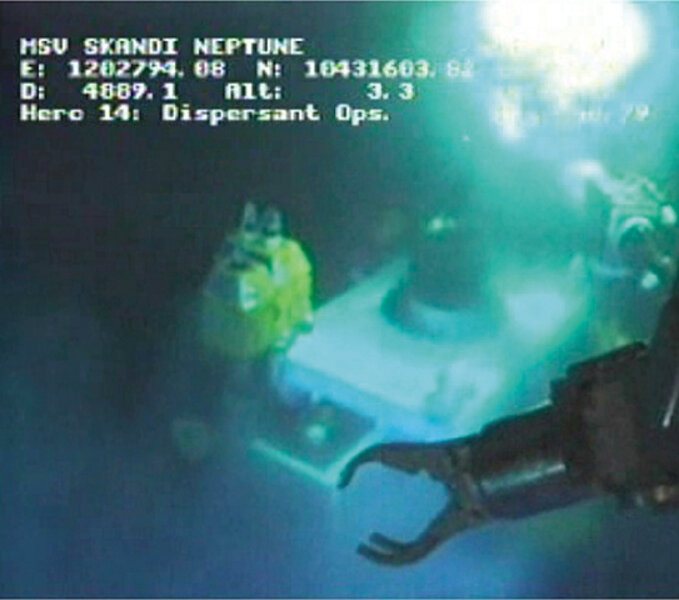Gulf oil spill: As gusher stops, response playbook is being rewritten
Loading...
Until about two months into the Deepwater Horizon disaster, the best petroleum engineers and geologists in the world had played by decades-old rules in trying to stop the Gulf oil spill.
They dropped a dome over the leak; they shot junk into the assembly from which the oil was gushing; they stuck a siphon into a leaky pipe. In short, they ran through the playbook of all the things a company is supposed to do to stop or slow a blowout.
Now, however, the playbook has changed. Three months of poking and prodding an offshore oil leak unlike any other in history – 5,000 feet down, where the waters of the Gulf of Mexico press down with seven tons of pressure per square inch – have recast how companies will respond to future deep-sea accidents.
IN PICTURES: The Gulf oil spill's impact on nature
On Friday, a new containment cap appeared to be holding steady, with no signs of oil leaking into the Gulf of Mexico. BP continued to conduct pressure tests to determine if the cap could shut in oil indefinitely, without damage.
Such a state is a far cry from the weeks-long dance around the crumpled riser pipe. That dance was done out of fear that cutting off the pipe might make things worse. But BP’s greatest successes all came after it sheared off the pipe and put a cap on the well.
Thus, any future deep-sea accidents won't hesitate to take on a damaged riser pipe. That’s just one of many lessons large and small that have come from what amounted to the largest and most costly crash course ever in deep-water petroleum engineering.
“The good thing that’s going to come out of this disaster is the incredible amount of research and development that has occurred in the last 90 days that could be used in future catastrophes,” says Houston-based oil industry expert Robert Bryce, author of “Power Hungry.” “There’s now a potential to have a stockpile of hardware like these containment caps that wouldn’t have to be fashioned in a big hurry. It’s not just about having enough boom on hand anymore.”
Most of all, engineers have learned what doesn’t work.
The cautious, early approach to containing leaks along the kinked riser pipe – which had been connected to the Deepwater Horizon but fell to the seafloor when the rig sank – in retrospect may have wasted precious time.
Likewise, the failure of the large containment dome early in the response means future spill responders can skip that kind of approach.
Success from failure
Yet as BP engineers and government scientists struggled day and night to end the troublesome spill, each failure brought them closer to success, yielding reams of data about the behavior of deep-water runaway wells.
Asked why the containment cap wasn’t tried earlier, BP executive Doug Suttles told reporters on July 12: “The problem is, I’ve had to take these steps to learn the things I’ve learned. We’re not only fighting the spill with the tools that were available to us at the time, we’ve been adding and trying new things constantly.”
The dome did give engineers new insights into the behavior of methane gas under pressure, as methane crystals quickly clogged the dome’s hose connections. In the containment caps used later, that was solved by using different valve configurations.
When analyzed, other data could prove just as useful. For example, BP’s failed “top kill” effort to plug the well with drilling mud raised more questions than it answered: Large amounts of drilling mud seemed to vanish. Some engineers worried that the mud must have escaped into cracks in the well bore – a potentially serious problem that could cause oil to blow out the side of the well in a new gusher.
When BP stopped the gushing oil on Thursday, it was testing to see if the well bore beneath was indeed damaged. Those integrity tests will tell engineers about how pressures in wells function at such depths. It is information that engineers can use in the future to determine how quickly they can shut down a well and not damage it further.
Transformative work
The work will change the oil industry, said Mr. Suttles. “What I can tell you ... is [that] when this spill is done, the capability of the industry and the government to respond to something like this will be very different than it was on the day it started,” he said.
Few people know as much about the rumblings and groans of Earth’s crust as oil company geologists. With a hefty profit motive, they’ve designed the complex hardware necessary to dig at ever greater depths.
But cleanup and containment technologies have lagged, with BP having to rely on decades-old containment methods and equipment that was cobbled together in an emergency, says Robert Bea, a former Shell executive and now an engineering professor at the University of California at Berkeley.
“I call [that discrepancy] Bob’s Equation for Disaster: A + B = C,” says Dr. Bea, who has studied the Deepwater Horizon spill. “A equals natural hazards – Mother Nature at her worst; B equals human hubris, greed, and ignorance; and C is a disaster sooner or later.”
For its part, all the industry can address is variable B, says Jorge Piñon, former president of Amoco Latin America.
“You will never be able to have a 100 percent risk-free environment in deep-water exploration,” he says, “so all that the industry can do, in cooperation with science and the government, is to develop manuals that somehow manage the risk and minimize the risk. Up until now, there was no manual."
IN PICTURES: The Gulf oil spill's impact on nature
Related:





